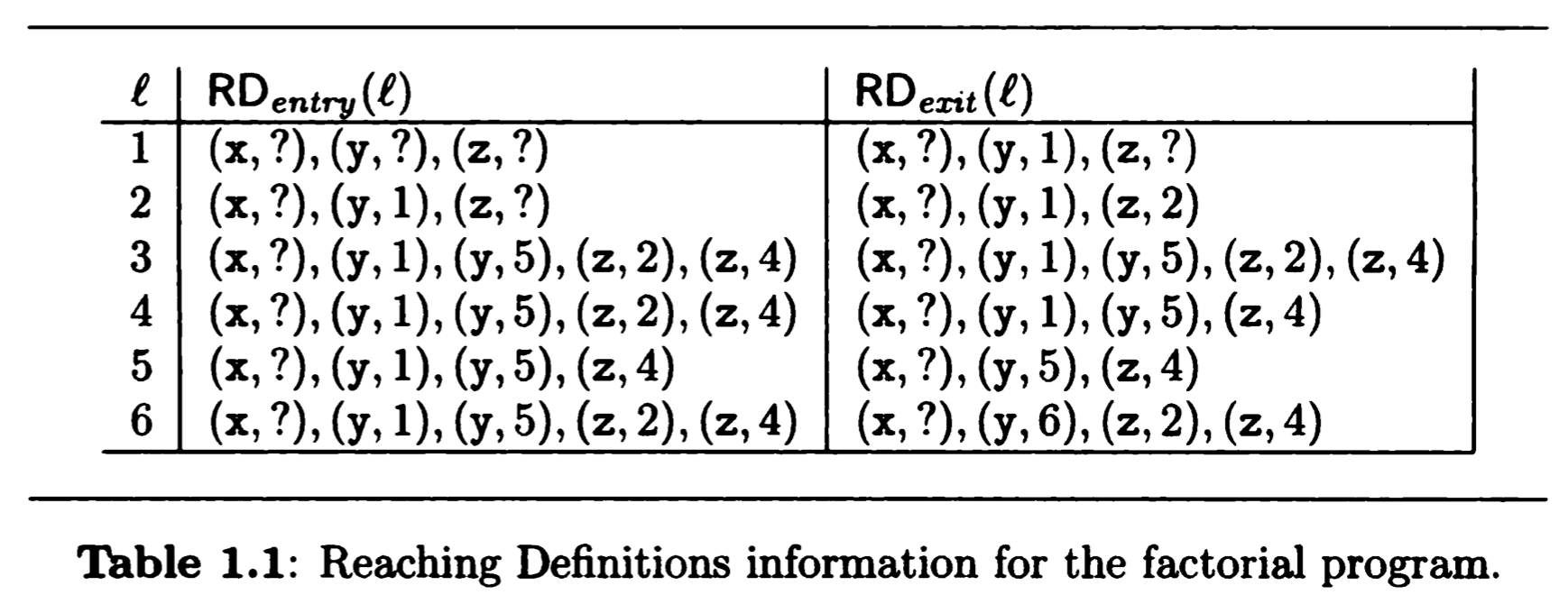I am currently studying the textbook Principles of Program Analysis by Flemming Nielson, Hanne R. Nielson, and Chris Hankin. Chapter 1.3 Data Flow Analysis says the following:
The least solution. The above system of equations defines the twelve sets $$\text{RD}_\text{entry}(1), \dots, \text{RD}_{\text{exit}}(6)$$ in terms of each other. Writing $\overrightarrow{RD}$ for this twelve-tuple of sets we can regard the equation system as defining a function $F$ and demanding that: $$\overrightarrow{RD} = F(\overrightarrow{RD})$$ To be more specific we can write $$F(\overrightarrow{RD}) (F_\text{entry}(1)(\overrightarrow{RD}), F_\text{exit}(1)(\overrightarrow{RD}), \dots, F_\text{entry}(6)(\overrightarrow{RD}), F_\text{exit}(6)(\overrightarrow{RD}))$$ where e.g.: $$F_\text{entry}(3)(\dots, \overrightarrow{RD}_\text{exit}(2), \dots, \overrightarrow{RD}_\text{exit}(5), \dots) = \overrightarrow{RD}_\text{exit}(2) \cup \overrightarrow{RD}_\text{exit}(5)$$ It should be clear that $F$ operates over twelve-tuples of sets of pairs of variables and labels; this can be written as $F : (\mathcal{P}(\mathbf{\text{Var}_\star \times \mathbf{\text{Lab}_\star}))}^{12} \to (\mathcal{P}(\mathbf{\text{Var}_\star \times \mathbf{\text{Lab}_\star}))}^{12}$ where it might be natural to take $\mathbf{\text{Var}_\star} = \mathbf{\text{Var}}$ and $\mathbf{\text{Lab}_\star} = \mathbf{\text{Lab}}$. However, it will simplify the presentation in this chapter to let $\mathbf{\text{Var}_\star}$ be a finite subset of $\mathbf{\text{Var}}$ that contains the variables occurring in the program $\mathbf{S_\star}$ of interest and similarly for $\mathbf{\text{Lab}_\star}$. So for the example program we might have $\mathbf{\text{Var}_\star} = \{ x, y, z \}$ and $\mathbf{\text{Lab}_\star} = \{ 1, \dots, 6, ? \}$.
It is immediate that $(\mathcal{P}(\mathbf{\text{Var}_\star \times \mathbf{\text{Lab}_\star}))}^{12}$ can be partially ordered by setting $$\overrightarrow{\text{RD}} \sqsubseteq \overrightarrow{\text{RD}}^\prime \ \ \ \text{iff} \ \ \ \forall i : \text{RD}_i \subseteq \text{RD}_i^\prime$$ where $\overrightarrow{\text{RD}} = (\text{RD}_1, \dots, \text{RD}_{12})$ and similarly $\overrightarrow{\text{RD}}^\prime = (\text{RD}_1^\prime, \dots, \text{RD}_{12}^\prime)$. This turns $(\mathcal{P}(\mathbf{\text{Var}_\star \times \mathbf{\text{Lab}_\star}))}^{12}$ into a complete lattice (see Appendix A) with least element $$\overrightarrow{\emptyset} = (\emptyset, \dots, \emptyset)$$ and binary least upper bounds given by: $$\overrightarrow{\text{RD}} \sqcup \overrightarrow{\text{RD}}^\prime = (\text{RD}_1 \cup \text{RD}_1^\prime, \dots, \text{RD}_{12} \cup \text{RD}_{12}^\prime)$$
It is easy to show that $F$ is in fact a monotone function (see Appendix A) meaning that: $$\overrightarrow{\text{RD}} \sqsubseteq \overrightarrow{\text{RD}}^\prime \ \ \ \text{implies} \ \ \ F(\overrightarrow{\text{RD}}) \sqsubseteq F(\overrightarrow{\text{RD}})^\prime$$ This involves calculations like $$\text{RD}_\text{exit}(2) \subseteq \text{RD}_\text{exit}^\prime(2) \ \ \text{and} \ \ \text{RD}_\text{exit}(5) \subseteq \text{RD}_\text{exit}^\prime(5)$$ imply $$\text{RD}_\text{exit}(2) \cup \text{RD}_\text{exit}(5) \subseteq \text{RD}^\prime_\text{exit}(2) \cup \text{RD}_\text{exit}^\prime(5)$$ and the details are left to the reader.
Appendix A gives the following definition for monotone function:
The function $f$ is monotone (or isotone or order-preserving) if $$\forall l, l^\prime \in L_1 : l \sqsubseteq_1 l^\prime \Rightarrow f(l) \sqsubseteq_2 f(l^\prime)$$
From earlier in the textbook:
I am trying to do as the author said, and show that $F$ is a monotone function. However, I have so far been unable to make progress. It seems to me that such a proof should proceed by showing that, for some arbitrary element of the set of elements $F(\overrightarrow{\text{RD}})$, if we use the fact that $\overrightarrow{\text{RD}} \sqsubseteq \overrightarrow{\text{RD}}^\prime$, then we can deduce that said arbitrary element is also an element of the set $F(\overrightarrow{\text{RD}})^\prime$, and so $F(\overrightarrow{\text{RD}}) \sqsubseteq F(\overrightarrow{\text{RD}})^\prime$. However, it seems to me that the textbook is very poorly written, and so it is difficult for me to even understand what said arbitrary elements of the set $F(\overrightarrow{\text{RD}})^\prime$ even are (they seem to be some kind of cartesian product, but I get very confused when trying to figure out precisely what they are). So how is it shown that $F$ is a monotone function?


